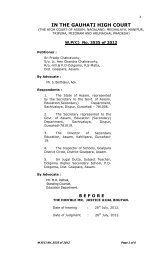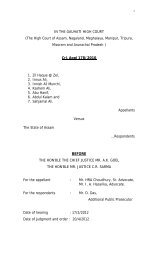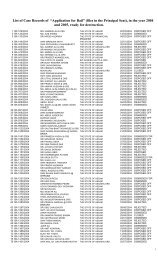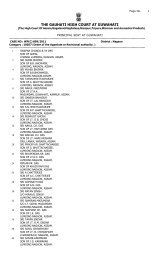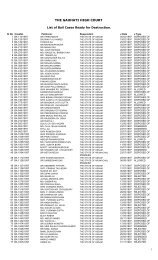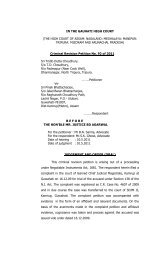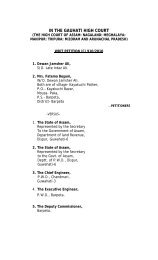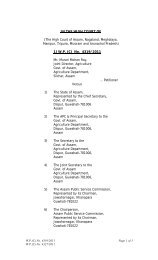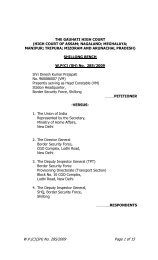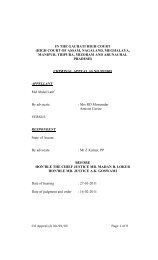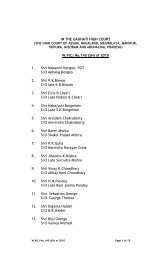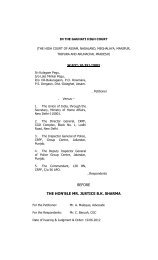Crl.A(J) 165/2004 - Gauhati High Court
Crl.A(J) 165/2004 - Gauhati High Court
Crl.A(J) 165/2004 - Gauhati High Court
You also want an ePaper? Increase the reach of your titles
YUMPU automatically turns print PDFs into web optimized ePapers that Google loves.
IN THE GAUHATI HIGH COURT<br />
(THE HIGH COURT OF ASSAM: NAGALAND: MEGHALAYA:<br />
MANIPUR: TRIPURA: MIZORAM AND ARUNACHAL PRADESH)<br />
Criminal Appeal No. <strong>165</strong>(J) of <strong>2004</strong><br />
The State of Assam<br />
-Versus-<br />
1. Golbar Hussain<br />
S/o Lt. Mahez Paramanic,<br />
Resident of Totpara,<br />
Kasari Bhita.<br />
2. Abu Sama,<br />
S/o Lt. Insan Ali,<br />
Resident of Haldiapara.<br />
3. Abdul Baten,<br />
S/o Lt. Mahez Paramanic,<br />
Resident of Tolapara,<br />
Kasaribhita.<br />
4. Jahir Ali,<br />
S/o Lt. Insan Ali,<br />
Resident of Haldiapara.<br />
5. Rahim Ali,<br />
S/o Lt. Insan Ali,<br />
Resident of Haldiapara.<br />
All are residents of Chapar, Dist. Dhubri.<br />
……. Appellant<br />
……. Respondents<br />
Advocates for the appellant<br />
Advocates for the respondents<br />
: Mr Z.Kamar,<br />
PP, Assam<br />
: Mr. K.C. Roy and<br />
Mr. HR Ahmed<br />
Criminal Appeal No.<strong>165</strong>(J)/04 Page 1 of 1
PRESENT<br />
THE HON’BLE CHIEF JUSTICE MR. AK GOEL<br />
HON’BLE MR. JUSTICE B D AGARWAL<br />
Date of hearing : 9.08.2012<br />
Date of Judgment : 31.08.2012<br />
JUDGEMENT AND ORDER (CAV)<br />
B D Agarwal, J.<br />
This appeal under Section 370 of the Code of Criminal<br />
Procedure has been filed by the State challenging the judgment<br />
and order dated 29.7.2003 passed by the learned Sessions<br />
Judge, Dhubri in Sessions Case No. 20 of 2002 whereby the<br />
learned Sessions Judge has acquitted all the five accused<br />
persons from the offence of murder by forming an unlawful<br />
assembly.<br />
2. We have heard Mr. Z. Kamar, learned Public Prosecutor<br />
for the State as well as Mr. K.C. Roy, learned counsel appearing<br />
for the accused persons/respondents. Sri HR Ahmed, learned<br />
counsel appeared for the informant and he was also heard. We<br />
have also gone through the impugned judgment and the<br />
evidence proffered by the prosecution in the trial court.<br />
3. The defence case was of total denial. Though the accused<br />
persons were residing in the nearby village under the same<br />
police station of the deceased and the deceased was wellknown<br />
to the accused persons they have expressed their<br />
ignorance about the murder of Hasen Ali and all the five<br />
Criminal Appeal No.<strong>165</strong>(J)/04 Page 2 of 2
accused persons took the plea of total denial and no evidence in<br />
defence was tendered in the trial court.<br />
4. The offence of murder took place at about 6.00 PM on<br />
5.1.2001 by the side of a public road. At the relevant time, the<br />
deceased was returning home from Chapar market along with<br />
PWs 4 and 5 and on the way the accused persons suddenly<br />
appeared at the scene from all the four sides and attacked the<br />
deceased with various kinds of sharp and pointed weapons and<br />
hacked him to death.<br />
5. The FIR was lodged by the son of the deceased on the<br />
very same day narrating the aforesaid story and also<br />
specifically naming five accused persons in the crime. The FIR<br />
was registered as Chapor Police Station Case No.3 of 2001<br />
under Sections 147/148/149/341/302 of the Indian Penal Code.<br />
The case was investigated by Sub-Inspector, Sri S.C. Biswas<br />
(PW 9). The Investigating Officer has confirmed in his<br />
testimony that initially the information of murder was received<br />
from the informant at 6.15 PM. From the printed form of the<br />
FIR it is gathered that the written FIR was lodged at 10.00 PM<br />
i.e., within four hours of the incident. After the charge-sheet,<br />
the accused persons were tried only for the offence under<br />
Section 302 read with Section 149 of the Indian Penal Code and<br />
after the trial all the five accused persons have been acquitted.<br />
Hence, this appeal at the instance of the State.<br />
6. Before venturing to examine the legality and correctness<br />
of the impugned judgment as well as appreciating the<br />
prosecution evidence, it would be just and proper to have a<br />
Criminal Appeal No.<strong>165</strong>(J)/04 Page 3 of 3
ief look about the legal position of an appeal against<br />
acquittal. Adverting to various authorities, the Hon’ble<br />
Supreme <strong>Court</strong> in the case of Chandrappa and Ors –Vs- State<br />
of Karnataka; reported in (2007) 4 SCC 415 : 2007 CriLJ 2136<br />
has culled out the following legal principles:<br />
“30. From the above decisions, in our considered<br />
view, the following general principles regarding<br />
powers of appellate <strong>Court</strong> while dealing with an<br />
appeal against an order of acquittal emerge;<br />
(1) An appellate <strong>Court</strong> has full power to review,<br />
reappreciate and reconsider the evidence upon which<br />
the order of acquittal is founded;<br />
(2) The Code of Criminal Procedure, 1973 puts no<br />
limitation, restriction or condition on exercise of such<br />
power and appellate <strong>Court</strong> on the evidence before it<br />
may reach its own conclusion, both on question of<br />
fact and of law.<br />
(3) Various expressions, such as, ‘substantial and<br />
compelling reasons’, ‘good and sufficient grounds’,<br />
‘very strong circumstances’, ‘distorted conclusions’,<br />
‘glaring mistakes’, etc. are not intended to curtail<br />
extensive powers of an appellate <strong>Court</strong> in an appeal<br />
against acquittal. Such phraseologies are more in the<br />
nature of ‘flourishes of language’ to emphasize the<br />
reluctance of an appellate <strong>Court</strong> to interfere with<br />
acquittal than to curtail the power of the <strong>Court</strong> to<br />
review the evidence and to come to its own<br />
conclusion.<br />
(4) An appellate <strong>Court</strong>, however, must bear in mind<br />
that in case of acquittal, there is double presumption<br />
in favour of the accused. Firstly, the presumption of<br />
innocence available to him under the fundamental<br />
principles of criminal jurisprudence that every person<br />
Criminal Appeal No.<strong>165</strong>(J)/04 Page 4 of 4
shall be presumed to be innocent unless he is proved<br />
guilty by a competent court of law. Secondly, the<br />
accused having secured his acquittal, the presumption<br />
of his innocence is further reinforced, reaffirmed and<br />
strengthened by the trial court.<br />
(5) If two reasonable conclusions are possible on<br />
the basis of the evidence on record, the appellate<br />
court should not disturb the finding of acquittal<br />
recorded by the trial court.”<br />
7. In the aforesaid judgment itself, the Apex <strong>Court</strong> also<br />
referred to the judgment of Kallu –Vs- State of M.P.; reported<br />
in 2006 CriLJ 799 and it would be profitable to reproduce the<br />
observations of Their Lordships given in the said judgment,<br />
which are as follows :<br />
“While deciding an appeal against acquittal, the<br />
power of the Appellate <strong>Court</strong> is no less than the<br />
power exercised while hearing appeals against<br />
conviction. In both types of appeals, the power exists<br />
to review the entire evidence. However, one<br />
significant difference is that an order of acquittal will<br />
not be interfered with, by an appellate court, where<br />
the judgment of the trial court is based on evidence<br />
and the view taken is reasonable and plausible. It<br />
will not reverse the decision of the trial court merely<br />
because different view is possible. The appellate court<br />
will also bear in mind that there is a presumption of<br />
innocence in favour of the accused and the accused is<br />
entitled to get the benefit of any doubt. Further if it<br />
decides to interfere, it should assign reasons for<br />
differing with the decision of the trial court”.<br />
8. Learned Public Prosecutor also cited a judgment of the<br />
Hon’ble Supreme <strong>Court</strong> in the case of the Jugender Singh Vs-<br />
Criminal Appeal No.<strong>165</strong>(J)/04 Page 5 of 5
State of U.P.; reported in 2012 CriLJ 3005. In this judgment<br />
also, the apex court has reiterated the same principles. The<br />
learned counsel for the respondents also referred to the<br />
decision of the Apex <strong>Court</strong> given in the case of Babu & Ors.–<br />
Vs- State of U.P. (AIR 1983 SC 308) to argue that acquittal of an<br />
accused gives a presumption of innocence and if two views are<br />
possible, the view favourable to the accused should be taken<br />
into consideration. The observations of their Lordships,<br />
borrowed from the case of U.P. State –v- Samman Dass (1972<br />
CriLJ 487) are quoted below and we would certainly follow the<br />
legal principles as to when an order of acquittal should be<br />
interfered with.<br />
"There are, however, certain cardinal rules<br />
which have always to be kept in view in appeals<br />
against acquittal. Firstly, there is a presumption of<br />
innocence in favour of the accused which has to be<br />
kept in mind, especially when the accused has been<br />
acquitted by the court below; secondly, if two views<br />
of the matter are possible, a view favourable to the<br />
accused should be taken thirdly, in case of acquittal<br />
by the trial judge, the appellate court should take<br />
into account the fact that the trial judge had the<br />
advantage of looking at the demeanour of witnesses;<br />
and fourthly, the accused is entitled to the benefit<br />
of doubt. The doubt should, however, be reasonable<br />
and should be such which rational thinking men<br />
will reasonably, honestly and conscientiously<br />
entertain and not the doubt of a timid mind which<br />
fights shy-though unwittingly it may be-or is afraid<br />
of the logical consequences, if that benefit was not<br />
given."<br />
Criminal Appeal No.<strong>165</strong>(J)/04 Page 6 of 6
9. Now coming to the merit of the case, it appears that<br />
altogether 10 witnesses were examined by the prosecution to<br />
establish the murder of one Hasen Ali at the hands of the<br />
appellants.<br />
10. PW 1 has deposed that while he was purchasing medicine<br />
in a pharmacy he met PW 4, who told the witness crying that<br />
his brother Hasen Ali was killed in the market. Thereafter PW 1<br />
visited the place of incidence and saw the dead body with cut<br />
wounds on head and abdomen etc and in his presence the<br />
police officer seized a pair of sandal, one bag containing a<br />
khukri, two handmade bombs, one shawl and one bicycle<br />
under Ext. 1.<br />
11. PW 2 was the owner of a sweet-meet shop at Chapor<br />
market. According to him, the deceased was the President of<br />
Gaon Panchayat. The witness has further deposed that he was<br />
reported by PW 4 about the murder of Hasen Ali. This witness<br />
did not visit the place of murder. His testimony is only relevant<br />
to establish the presence of PW 4 at the place of occurrence at<br />
the relevant time.<br />
12. PW 3 is the son of the deceased and he is also the<br />
informant of the case. This witness has deposed that he was<br />
informed about the assault upon his father by his uncle Sah<br />
Alam. PW 3 was also told about the names of five assailants<br />
and thereafter the written FIR (Ext 2) was submitted. The<br />
witness was cross-examined to elicit that he did not name any<br />
assailant before the Investigating Officer. Be that as it may, the<br />
witness has given incriminating evidence in the cross-<br />
Criminal Appeal No.<strong>165</strong>(J)/04 Page 7 of 7
examination by deposing that his father (deceased) was an<br />
accused in a murder case lodged by one Sahar Ali and Jahar Ali<br />
and the said case is still pending for disposal. It may be<br />
mentioned herein that Jahar Ali is one of the<br />
accused/respondents in this case. In this way, Jahar Ali must<br />
have been a prosecution witness in the murder case against the<br />
deceased. As per the defence suggestion to the witness the<br />
deceased was also an accused in another murder case of Abdul<br />
Mazid. From these facts it is apparent that a group of persons,<br />
including the accused persons were entertaining grudge<br />
against the deceased.<br />
13. PW 4 is one of the two eye witnesses of the offence. He is<br />
the step brother of the deceased. According to PW 4 at the<br />
relevant time, he was in the market along with the deceased<br />
Hasen Ali and PW 5 Jahar Ali and all three of them were going<br />
together to the house of the deceased to purchase kerosene oil,<br />
since the deceased was running a fair price shop. According to<br />
PW 4, suddenly accused Golbar appeared from the right side<br />
and accused Abu Sama appeared from the left side and started<br />
assaulting Hasen Ali with daggers in his abdomen. The witness<br />
has further deposed that the accused Baten came from the front<br />
and dealt Khukri blows on the neck of the deceased and when<br />
the deceased fell down on the road he was simultaneously<br />
attacked by all the accused persons. According to PW 4 he<br />
could identify only five accused persons but some more<br />
persons were also involved. PW 4 has corroborated the<br />
informant deposing that immediately after the incident he went<br />
to the shop of Amir Hussain (PW 3) and reported about the<br />
incident. PW 4 has given additional incriminating evidence<br />
Criminal Appeal No.<strong>165</strong>(J)/04 Page 8 of 8
against the accused persons by deposing that accused Abu<br />
Sama was earlier convicted in an assault case upon the<br />
deceased.<br />
14. In the cross-examination PW 4 has deposed that he had<br />
come to Chapor market on the previous day but PW 5 came to<br />
the market on the same day. The witness has further clarified<br />
that he met PW 5 in the market in the afternoon and both of<br />
them had accompanied the deceased to his grocery shop. The<br />
witness has been cross-examined to ascertain whether he could<br />
see the assailants. The witness has stated that the deceased was<br />
going ahead and the distance in between them was that of only<br />
5 cubits. The witness has admitted that when some of the<br />
assailants obstructed him he retreated up to a distance of 15<br />
cubits. The witness was further cross-examined that he did not<br />
give a graphic statement before the Investigating Officer as to<br />
from which direction which accused came and which accused<br />
inflicted what injury.<br />
15. PW 5 Jahar Ali is the prime witness of the prosecution. He<br />
is the brother-in-law of the deceased inasmuch as his sister was<br />
married to deceased’s brother. He is also the eye witness of the<br />
offence of murder. His testimony is by and large the same,<br />
which has been narrated by PW 4. Before going to the house of<br />
the deceased he met PW 4 and the deceased in a tea stall and<br />
thereafter all the three were going to the house of the deceased<br />
to purchase kerosene oil since the deceased was running a fair<br />
price shop. According to PW 5, the deceased was few steps<br />
ahead of them and the deceased was also pulling a bicycle.<br />
Suddenly, all the five respondents appeared at the scene from<br />
Criminal Appeal No.<strong>165</strong>(J)/04 Page 9 of 9
different sides and after gheraoing the deceased each one of<br />
them assaulted Hasen Ali by different weapons. Though,<br />
according to PW 5 few more persons were there but he could<br />
not identify the remaining persons. The witness has further<br />
elaborated as to which accused was carrying what weapon and<br />
how they assaulted the deceased. PW 5 has further deposed<br />
that seeing the incident PW 4 ran away to inform the son of the<br />
deceased and, after some time, the police came to the site of the<br />
offence and seized one bag containing two numbers of bombs<br />
and one Khukri. Besides this, PW 5 has further spoken about<br />
the enmity between the deceased and the accused Abu Sama<br />
since the said accused was convicted in a case of assault upon<br />
the deceased.<br />
16. PW 5 was cross-examined to elicit certain omissions as to<br />
which accused was carrying what weapon and what injury was<br />
inflicted by each one of them. The witness was suggested in the<br />
cross-examination that the deceased was also implicated in a<br />
murder case and the bombs and Khukri recovered from the bag<br />
belonged to the deceased. Except giving a casual suggestion<br />
that the accused persons have been falsely implicated, no<br />
specific suggestion was given as to why the accused persons<br />
were falsely implicated. However, from one of the suggestions,<br />
it can be inferred that the accused persons have been falsely<br />
implicated since the accused Jahir and Rahim were witnesses in<br />
a murder case against the deceased. On the other hand, this<br />
suggestion clearly proves that there was deep rooted enmity<br />
between the accused persons and the deceased and both the<br />
parties were entangled in physical fights and filing cases<br />
against each other.<br />
Criminal Appeal No.<strong>165</strong>(J)/04 Page 10 of 10
17. PW 6 is the uncle of the deceased. After hearing the<br />
incident in the market he visited the place of occurrence and<br />
saw Hasen Ali lying dead. This witness has further deposed<br />
that in his presence police came for investigation and seized<br />
one bicycle and a bag, containing one Khukri and two bombs<br />
vide Ext-1. PW 6 is also a witness to the inquest report. In the<br />
cross-examination, he has admitted that he was also an accused<br />
in a case of murder of Jahar and Sahar. PW 3 has also admitted<br />
in the cross-examination that his father was also an accused in<br />
the same murder case. Be that as it may, one new fact has<br />
emerged in the cross-examination of PW 6 that just four days<br />
prior to the murder of Hasen Ali, the witnesses had harvested<br />
black gram along with the deceased that was cultivated by the<br />
accused and one day prior to the murder, the deceased had<br />
allegedly assaulted one Ajahar and Samsul. In this way, PW 6<br />
has also spoken about the enmity in between accused and the<br />
deceased.<br />
18. PW 7 is the doctor who had conducted necropsy on the<br />
dead body. It is necessary to reproduce the number and nature<br />
of the injuries, which will answer the question as to whether the<br />
culpable homicide of Hasen Ali was intentional and as to<br />
whether five persons could be involved in the said offence. The<br />
external injuries are as below :<br />
“1. Cut injury 3” x ½” x ½ in right side of scalp.<br />
2. Cut injury 1” x ½” x 1/3” in right ears.<br />
3. Cut injury 2” x 1” x ½” in left side of face.<br />
4. Deep lacerated wound in left side of neck 6”x2”x<br />
6”, injuring all the major blood vessels.<br />
Criminal Appeal No.<strong>165</strong>(J)/04 Page 11 of 11
5. Penetrating wound 1”x ½” x3” in right side of<br />
abdomen piercing the liver.<br />
6. Lacerated wound 4”x3”x3” in right wrist joint and<br />
palm.<br />
7. Left little finger is cut.<br />
8. Cut injury is right side of lower abdomen 3”x ½ “ x<br />
1”.<br />
9. Multiple penetrating wounds (12 No.) 2” x ½ “x 1”<br />
present in back.”<br />
19. In the opinion of the doctor, the injuries were antemortem<br />
in nature and the person died due to injuries sustained<br />
by him. The doctor was not cross-examined on any point.<br />
20. From the numbers, situs and nature of the wounds we<br />
have no hesitation to hold that the appellants had definite<br />
intention to commit murder of the victim. Going by the<br />
numbers of the injuries inflicted on the deceased possibility of<br />
involvement of five persons also cannot be totally discounted.<br />
At the same time, the autopsy findings also corroborate the<br />
testimony of PWs 4 and 5, wherein they have deposed that the<br />
deceased was assaulted from left, right, front and back.<br />
21. PW 8 is virtually a witness to the seizure of bag and other<br />
articles from the place of occurrence. In the cross-examination,<br />
the witness has deposed that on being enquired PWs 4 and 5<br />
could not say as to who had committed murder. However, this<br />
statement was not made before the Investigating Officer. In his<br />
statement under Section 161 Cr.P.C., PW 8 had only stated that<br />
he could not say as to who had killed Hasen Ali. Be that as it<br />
may, PW 8 has also corroborated PW 7 by deposing in the<br />
cross-examination that the deceased had harvested pulses 4/5<br />
Criminal Appeal No.<strong>165</strong>(J)/04 Page 12 of 12
days ago from 160 Bighas of land of one Mahar Ali, who is the<br />
brother of the accused Jahar Ali, for whom a murder case was<br />
lodged and Hasen Ali was an accused in the said case. The<br />
witness was basically cross-examined to project a story that the<br />
deceased was involved in a number of criminal cases.<br />
22. PW 9 is the Investigating Officer and PW 10 is the Officerin-Charge<br />
of the Chapor Police Station, who had finally<br />
submitted the charge sheet.<br />
23. Sri Roy, learned counsel for the respondents argued that<br />
the testimonies of PWs 4 and 5 are contradictory on material<br />
points. According to the learned counsel, PW 4 has deposed<br />
that he had come to Chapor market on the previous day,<br />
whereas PW 5 has admitted in the cross-examination that he<br />
and Shah Alam came to Chapor on the very day of the<br />
occurrence and this discrepancy was also taken note of by the<br />
learned Sessions Judge as material contradiction to record the<br />
judgment of acquittal. In our opinion, the contradiction can also<br />
be looked into from different angle. PW 4 has nowhere claimed<br />
in the examination in chief that he and PW 5 had come to<br />
Chapor together on the previous day. Rather, in the crossexamination,<br />
PW 4 has categorically stated that Jahar Ali (PW<br />
5) had come to Chapor on the very day of the incident and only<br />
in the afternoon they met in the market near a tea stall. The<br />
evidence of PW 5 was recorded nearly after two years of the<br />
incident. Even otherwise, whether PWs 4 and 5 had come to<br />
Chapar from their respective villages on the previous day or on<br />
the same day is immaterial since their meeting in the afternoon<br />
in front of a tea stall has not been challenged. From the<br />
Criminal Appeal No.<strong>165</strong>(J)/04 Page 13 of 13
deposition of PWs 4 and 5 and other witnesses it is difficult to<br />
doubt the presence of PWs 4 and 5 at the place of occurrence.<br />
On the other hand, testimony of these two witnesses could not<br />
be impeached in the cross-examination to hold a view that they<br />
are either chance witnesses or planted by the prosecution to<br />
support a cooked-up story.<br />
24. The learned counsel for the respondents also submitted<br />
that PW 4 has admitted that within moments he had retreated<br />
from the place of occurrence to a distance of about 15 cubits<br />
and as such it could not have been possible for PW 4 to witness<br />
the crime. In our opinion, the argument has no force inasmuch<br />
as for some time PW 4 had seen the assault from a close<br />
distance of 5 cubits and only thereafter he was chased away.<br />
Besides this, there is no such statement from PW 5 that he was<br />
also chased away and that he could not identify the assailants.<br />
In our opinion, since all the accused persons were well known<br />
to the witnesses and since they had witnessed the assault from<br />
a distance of only 5 cubits it might not have been difficult for<br />
them to identify the assailants. There was no suggestion to PWs<br />
4 and 5 that they could not identify the assailants due to<br />
darkness. On the other hand, the admitted fact is that there<br />
were good number of shops nearby and, particularly, one<br />
godown and a Govt. office and as such there must have been<br />
sufficient light at the place of occurrence.<br />
25. According to the learned Sessions Judge neither PW 3 nor<br />
PW 4 mentioned the name of the accused persons in their<br />
statement under Section 161 Cr.P.C. This finding of the learned<br />
Sessions Judge is totally perverse and factually incorrect. Both<br />
Criminal Appeal No.<strong>165</strong>(J)/04 Page 14 of 14
these witnesses had specifically named all the five respondents<br />
as assailants of Hasen Ali. Strangely, in the cross-examination,<br />
the Investigating Officer also did not say that PWs 4 and 5 did<br />
not name the accused persons as the offenders. The<br />
Investigating Officer was confronted by the defence only to<br />
contradict the parts of the body on which the deceased was<br />
assaulted. Both PWs 4 and 5 had stated before the Investigating<br />
Officer that the accused persons had assaulted Hasen Ali at<br />
random at different places but while giving depositions in the<br />
court the witnesses have just clarified as to on which part of the<br />
body assaults were inflicted. Hence, we hold that the view<br />
taken by the learned Sessions Judge about material<br />
contradictions is not correct.<br />
26. The learned Sessions Judge has also relied upon the<br />
testimony of PW 1 to take a view that PW 4 did not disclose the<br />
names of the assailants when PW 1 met him near a pharmacy.<br />
In our considered opinion, the testimony of PW 1 has been<br />
twisted in favour of the accused persons without giving any<br />
thought as to under what circumstance both PWs 1 and 4 met<br />
each other. Apparently, PW 4 was in a hurry to report the<br />
incident to the son of the deceased. PW 1 was apparently not a<br />
relative of the deceased and as such PW 4 may not have<br />
thought it necessary to give vivid description of the incident,<br />
including the names of the assailants. Be that as it may, PW 1<br />
has nowhere stated that he had specifically enquired from Sah<br />
Alam (PW 4) as to who had committed the murder and without<br />
any such question PW 4 may not have discussed the incident in<br />
detail. In this way, the testimony of PW 1 cannot be said to be<br />
Criminal Appeal No.<strong>165</strong>(J)/04 Page 15 of 15
not in favour of the prosecution, far less giving any testimony<br />
in favour of the accused persons.<br />
27. The learned Sessions Judge has also taken an exception<br />
that though the incident took place in the market area no<br />
shopkeeper has come forward to support the prosecution case.<br />
According to the learned Sessions Judge, PW 5 has admitted in<br />
the cross-examination that he knew two shopkeepers; one<br />
Sattar and another Hazarat and the said Hazarat (PW 2) has not<br />
supported the prosecution case by deposing that the incident<br />
had taken place in front of his shop.<br />
27.1. In our considered opinion, this finding is also absurd and<br />
not based on record. Firstly, PW 5 has not specifically stated<br />
that the murder took place just in front of the shop of PW 2 and;<br />
secondly, from the sketch map of the place of occurrence also it<br />
does not indicate that the shop of PW 2 was situated nearby.<br />
Besides this, we are of the firm view that the shop of PW 2 must<br />
have been situated at a sufficient distance from the place of<br />
occurrence. We hold so because PW 2 has deposed that even<br />
after hearing about the murder of the President of the Gaon<br />
Panchayat (Hasen Ali) he did not visit the place of occurrence<br />
since he was busy in the shop. Had the shop of PW 2 been<br />
situated very close to the scene he would have certainly visited<br />
the place of occurrence, despite being pre-occupied as this is<br />
the common human behavior.<br />
28. Lastly, the learned Sessions Judge has also recorded a<br />
wrong finding that the bag containing Khukri and two bombs<br />
belonged to the deceased persons (inadvertently typed as<br />
Criminal Appeal No.<strong>165</strong>(J)/04 Page 16 of 16
“accused persons”). Admittedly, no explosive materials were<br />
used in the murder. Besides this, various kinds of sharp<br />
weapons were used in the assault. Hence, the recovery of<br />
bombs and one Khukri and that too from a bag lying on the<br />
spot was immaterial and not connected in the incident. Even if<br />
it is assumed that these weapons were being carried by the<br />
deceased, the accused persons could not have been given any<br />
benefit from this recovery.<br />
29. The learned counsel for the respondents also submitted<br />
that since PWs 3, 4 and 5 are closely related to the deceased,<br />
their evidence should be scrutinized carefully. We fully agree<br />
with the learned counsel for the accused persons. There are<br />
scores of decisions in this regard and virtually it is the settled<br />
legal principle that if the witnesses are closely related to the<br />
deceased their testimony should be scanned meticulously.<br />
Some of the authorities on this point; including the case of Ram<br />
Ashrit Ram –vs- State of Bihar, reported in 1981 CriLJ 484 have<br />
already been referred in the impugned judgment. In this case<br />
the Hon’ble Supreme <strong>Court</strong> has observed that the testimonies<br />
of those witnesses who are highly interested, inimical and<br />
partisan and particularly when it bristles with improbable<br />
version and material infirmities it is not safe to rely on their<br />
testimonies. In our view the aforesaid authority is basically on<br />
particular facts of the case, although there cannot be any<br />
quarrel on the legal principle of close scrutiny of the evidence<br />
of related witnesses.<br />
30. At the same time, the Hon’ble Supreme <strong>Court</strong> has also<br />
held in the case of State of Rajasthan –Vs- Kalki (AIR 1981 SC<br />
Criminal Appeal No.<strong>165</strong>(J)/04 Page 17 of 17
1390) that the testimony of related witnesses cannot be thrown<br />
overboard and in appropriate cases, the relatives are the best<br />
witnesses, who are less likely to shield real culprits and<br />
implicate innocent persons. While setting aside a judgment of<br />
acquittal on the basis of ocular testimony of the wife of the<br />
deceased their Lordships have distinguished the evidentiary<br />
value of ‘related’ and ‘interested’ witness in the following<br />
words.<br />
“A witness may be called ‘interested” only when he<br />
or she derives some benefits from the result of a<br />
litigation; in the decree in a civil case or in seeing an<br />
accused person punished. A witness who is natural<br />
one and is the only possible eye witness in the<br />
circumstances of the case cannot be said to be<br />
‘interested’. In the instant case the PW 1 had no<br />
interest in protecting the real culprits and falsely<br />
implicating the respondents”<br />
31. In the instant case, we do not find over exaggeration of<br />
the facts or material and significant infirmities in the<br />
testimonies of prime witnesses. It is also not a case wherein it<br />
can be held that the prosecution evidence throws two views<br />
and the respondents can be given benefit of doubt.<br />
32. In view of the discussions made hereinabove, we have<br />
come to the conclusion that the impugned judgment suffers<br />
from perversity and the findings of the learned Sessions Judge<br />
are not based on evidence and materials on record. On the<br />
other hand, the prosecution evidence clearly proves that all the<br />
five accused persons/respondents were directly involved in the<br />
offence of murder by forming an unlawful assembly.<br />
Criminal Appeal No.<strong>165</strong>(J)/04 Page 18 of 18
33. In the result, the appeal stands allowed. The impugned<br />
judgment is hereby set aside. All the five respondents namely,<br />
Golbar Hussain, Abu Sama, Abdul Baten, Jahir Ali and Rahim<br />
Ali are hereby convicted under Section 302 r/w Section 149<br />
IPC. The respondents are directed to surrender in the court of<br />
learned Sessions Judge, Dhubri forthwith, failing which the<br />
learned Sessions Judge shall take steps to apprehend them<br />
to undergo conviction for the offence of murder. The<br />
respondents are sentenced to undergo Imprisonment for<br />
Life and also to pay fine of Rs. 10,000/-(ten thousand) each<br />
for their conviction under Section 302 r/w Section 149 IPC.<br />
In default of payment of fine, the convicts shall undergo further<br />
RI for six months each.<br />
34. The seized weapons are directed to be destroyed as per<br />
the Rules.<br />
35. Send down the records along with a copy of the<br />
judgment.<br />
36. In view of the provisions prescribed by Section 357-A<br />
Cr.P.C., the victim or his/her dependants are entitled to get<br />
compensation for rehabilitation in appropriate cases. In the<br />
light of the directions, given in the case of Jalilur Rahman –vs-<br />
State of Assam, reported in 2012(1) GLT 238, with regard the<br />
victim compensation, as provided by Section 357-A Cr.P.C., we<br />
make the following directions:<br />
Criminal Appeal No.<strong>165</strong>(J)/04 Page 19 of 19
(i) As an interim measure, an amount of<br />
Rs.50,000/- shall be deposited by the State<br />
Government with the District Legal Services<br />
Authority of Dhubri District within a period of<br />
two months from this date. The District Legal<br />
Services Authority, on receipt of the said money,<br />
shall make an enquiry to ascertain as to whether,<br />
there is dependant(s), who suffered loss and<br />
injury as a result of death of the deceased and if<br />
such dependent(s) or legal representative(s) need<br />
any rehabilitation.<br />
(ii) Upon such enquiry, if it is found that the<br />
dependent(s), if any, need rehabilitation, then the<br />
District Legal Services Authority shall initially<br />
release the said interim amount and thereafter<br />
direct payment of adequate compensation, as<br />
may be prescribed by the scheme to be prepared<br />
by the State Government. It is made clear that if<br />
the District Legal Services Authority, after due<br />
enquiry, arrive at the findings that there is no<br />
dependent(s) or that the dependent(s) of the<br />
deceased/victim does not require any<br />
rehabilitation, then the District Legal Services<br />
Authority, shall refund the said amount of<br />
Rs.50,000/- without delay, in favour of the State<br />
Government.<br />
Upadhaya<br />
JUDGE<br />
CHIEF JUSTICE<br />
Criminal Appeal No.<strong>165</strong>(J)/04 Page 20 of 20





